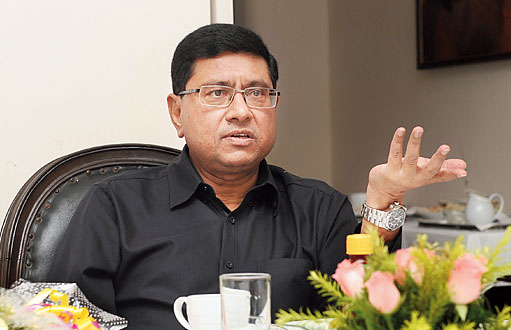The Narendra Modi-government’s decision to start a fresh round of consultations with industry to help them tide over the crippling effects of a slowdown needs to be welcomed. Domestic manufacturing desperately needs help to ride out the slump. Equally, we need to adopt measures to crank up exports. Idling factories should be incentivised to use their spare capacities to boost manufacturing for export markets.
But ideas are not enough; we need to implement them — and quickly. That is the only way to deliver on a promise.
Industry and the government need to work in tandem. Industry has been slashing costs to counter the effects of the economic slowdown. Now, the government needs to adopt a set of immediate measures that will help businesses to achieve the seemingly unattainable. Here is a compendium of measures that we need to take.

Sanjay Budhia Telegraph picture
Engine of export growth
Engineering exports constitute about 26 per cent of India’s total exports and has the potential to garner a bigger market share. It is a highly labour intensive sector. However, in the last one year, the price of steel, a basic raw material, has increased 20 per cent. This has made engineering exports unsustainable.
Steel mills export at a much lower price compared with the prices local mills pay. Engineering exporters buy steel from these local mills at very high prices. Exporters should be provided steel at competitive/export prices. Only offering this benefits to MSMEs will not serve the purpose.
Cost of credit
Interest rates of major competing countries are low while Indian exporters have to pay 6-7 per cent on loans. The Centre has offered an interest equalisation scheme from 3-5 per cent, which is only applicable for MSMEs. The benefit should be applicable to all exporters.
Competitiveness
Opening of trade windows because of the US-China trade tensions provide an opportunity for Indian exporters to get a foothold in the US market. Chinese exporters are offering their goods at a more than 10 per cent discount and the Chinese are regularly devaluing their yuan.
Our government should support exporters by enhancing MEIS and duty drawback rates at the earliest till another refund scheme is introduced. There are many taxes and levies which are not refunded through the GST mechanism, such as electricity duty, taxes on petroleum products.
Certification charges
For US markets, taking UL (underwriters laboratories ) certification is a pre-condition for exporting electrical products. The charges for UL listing are prohibitory. Such charges should be reimbursed by the ministry of commerce under the market access initiative (MAI).
Role of embassies
Embassies and High Commissions should be proactively engaged in gathering and sharing market intelligence in terms of new opportunities and also how and what the other governments are offering to their exporters.
Shipping regulator
Exporters are facing severe hardship because of a continuous rise in shipping freight to the US, Canada and even to European markets by the shipping lines. In absence of any National Shipping Line, our exporters are at the mercy of foreign shipping lines.
Special economic zones
SEZs were created with the objective of generating additional economic activity, promotion of exports and creation of employment opportunities.
Due to mid-term policy changes, many units in SEZs are finding it difficult to do business and carry on operations. The following remedial measures will go a long way in helping exporters.
A one-time 100 per cent income tax payment exemption for 10 years be provided and MAT be withdrawn at the earliest for all units operating in SEZs. Duty Drawback eligible on exports from DTA to SEZ should be credited to exporter's bank account similarly as exports through ICES, without the need to submit physical documents which will drastically reduce time, money and energy spent.
The author is chairman — CII national committee on Exim and managing director of Patton Group











